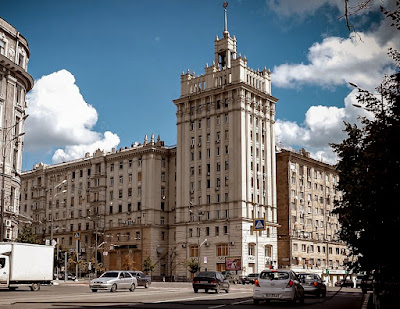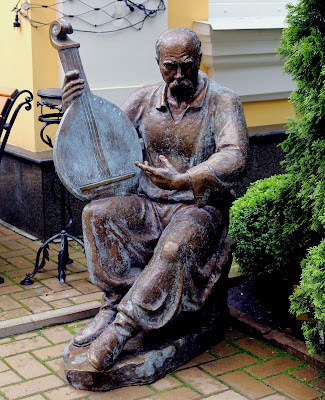I know this seems to have nothing to do with the purpose of this blog, the quest for Arctic and Antarctic remote or remarkable locations. But I am fully concerned with the future of Europe, and Kharkiv is a kind of "last frontier" to the east, a kind of Last Thule to preserve and cherish as a noble part of us all.
Stubbornly, bombs and missiles of the cursed invaders fall and disfigure the city. Just like Chernihiv, like Odessa, Kharkiv became a martyr city of Ukraine. I will not show this though, not the ruins and the fires that Ru卐卐ia daily produces, I will show the most brilliant, glorious European city that Kharkiv has been - confident that someday soon it will be reborn.
Kharkiv is as big as, say, Lisbon or Birmingham, the whole city doesn't fit in a small post here; so this is a quick visit focusing on what seems most interesting to me. It is a beautiful city, on both banks of the river Lopan.
Founded in 1654, Kharkiv has now a population of around 1.5 million; 6 museums, 7 theatres and some 80 libraries, top companies like Khartron (aerospace and nuclear electronics) and a University. But architecture is the star: art nouveau, neo-classical and Renaissance-style grand buildings, 19th-century brick houses from when the city was a home for Cossacks and a jewel of the Tsarist Russian Empire. Plus of course the heritage from Soviet era.
The rich architecture of Kharkiv.
The administrative city centre is Ploshcha Svobody (Freedom Plaza) around a park and dominated by an imposing complex of skyscrapers in the constructivist style of the 1930s in the USSR.

The Derzhprom was intended to celebrate the modernity and power of the Soviet State, at a time when the United States were also building large skyscrapers across the country. But it was also when Ukrainians were condemned to a criminal death by hunger - the regime 'offering' buildings and stealing all the grain it could.

The 1928 Derzhprom dominates the Plaza. It is a unique case in modern architecture from the first half of the 20th century.
Freedom Plaza has been hit repeatedly since March 2022, perhaps in fury at not being able to achieve the surrender of the city. The Plaza is shaped like a drop 💧, in which the arch is formed by the Derzham complex, and in the narrowest part it flows into Svoboda Street.
Svobody Square takes the form of a drop (piriform).
It is classified by UNESCO as a major work of constructivism, but it no longer serves the purpose of supporting the industry; after seven years of reconstruction, a large part is administrative, with services such as TV and radio; but the largest area is occupied by Kharkiv University, also targeted by missile attacks.

One of the most beautiful streets is Universitets'ka, where Kharkiv University has its main buildings. With the Assumption Tower in the background, two of the most striking university buildings face each other.
The University Church (1831) by architect Vasiliev, contained an observatory and library. Some serious damage was caused in March 2022 by a Russian missile.
The Governor Palace
Kharkiv University was established in 1805 in this manor house from the 18th century.

It was built as the Governor's Residence (1767-77), still under Catherine II, before being converted into the main Engineering building of the University.
Following downstreet, the Chemical Academy.
The Assumption Cathedral
Standing on University Hill, visible from almost everywhere, the Cathedral is the most striking landmark of architectural Kharkiv.
Built in 1657, Kharkiv Cathedral is its oldest church, though subject to successive restorations. The magnificent Alexandert Tower of 90 m was built separately in 1830, in honour to Alexander I 's victory over Napoleon.
View from the belfry
The University Library
The Library from 1804.
The Library, the Church, the University and the Museum have all been targeted by missiles or damaged by the blow, in addition to the worst of all - many residential buildings and casualties.
The cathedral's Alexander Tower is visible in a pretty frame from one of the central parks - the Cathedral Park, on top of the University Hill.
Several parks and fountains help to refine the city quality of Kharkiv.
Cathedral's Fountain
University Street leads to another large square, Maydan Konstytutsiyi - Constitution Square, which is perhaps the most classy place in the city, in an almost Viennese atmosphere. It is a vast square with a strange formulation, a square-within-a-square, which continues as a wide avenue.
In the center stands the Independence Statue "Fly, Ukraine", here seen with Universitets'ka Street in the background.
The new History Museum, partially glazed, was a recent expansion project at the square centre.
The east front of Constitution Square extends into a beautiful sequence of monumental classical buildings:
Part of these buildings were destroyed by Russian missiles.
"Art Nouveau" Puppet Theatre from 1907, as found in most East European cities.
We enter the busiest district now, the broad street following Maydan Konstytutsiyi.
This is the "heart" of Kharkiv, where people, services and commerce are concentrated.

The House with a Spire is one of the so-called "Seven Wonders of Kharkiv", a 11-story work for stalinist show off.
Depending on tastes, it can be appreciated as a brilliant landmark of Russia's post-war strength, or as a needless and extremely expensive piece of propaganda for the regime. In any case, it is a relevant historical legacy.
The prestigious building with its re-entrant curved corner, with the GorCafé at ground level.
It was built in 1954 as a residence for workers at a large electromechanical company (motors and turbines, transformers), KHMZ / VEK
The tower is on the corner of Heroes of Kharkiv Avenue (formerly 'Moskovka'). This is the most frequented and congested conjunction in the city; there is the GorCafé 16/54, short for 'Gorodskoe kafe', meaning City Café - now renamed Mis'ke.
.jpg)
A warm modern atmosphere, you can immediately see that this is Europe and not the creepy eastern neighbour.



Opposite is the Bratsk (Brotherhood) House, one of the most beautiful buildings in the city, from the end of the 19th century, now a prestigious commercial building.
Corner buildings are a speciality of Eastern Europe urban architecture.
Further ahead, at nº 11 Maydan Konstytutsiyi , in the large square corner, stands Vedmedik shop, the oldest and perhaps best gourmet pastry and biscuit shop in town, founded in 1900 in grand Art Nouveau building. The surrounding area is perfumed with sweet smells.
The name "ведмедик" means "teddy bear", a shop at the ground floor of the Academy of Arts building.
The interior, decorated in the Russian Empire style, is coated in glass and wood
The factory is yet older, it opened in 1862 and made chocolate, biscuits, jams and cakes.
Biscuits "Colour of Kharkiv" by Vedmedyk
Opposite to the University District in Constitution Square is the main central Metro station, at Bursats'ky Descent.
Bursats'ky Descent
One of the oldest parts of Kharkiv, the Descent is the location of the large Kharkiv Seminary, facing a steeply sloping garden.
The Seminary was first built in 1773, mostly for lodging ant teaching orphan students. Expansion in the 19th cent. decorated the façade in the neo-Byzantine style usual those times in Russia.
Presently it houses the University's Academy of Culture.
The cultural district streets can't be missed: Sumska street, Poetry and Theatre Squares.
Sumska Street , that follows Constitution Square to the North, is known for the Shevchenko Drama Theatre and its several examples of Art Nouveau style, otherwise it is a rather bleak street.
Built in 1841, in the heyday of the Russian Empire.
At nº 88, one of the best examples of Art Nouveau in Kharkiv:
Facing the Theatre, Poetry Square and its central garden leads to Chernichevska street.
House in Poetry Square
This is one more picturesque place in the city.
Of all streets, Darwin Street (vul. Darvina) is the winner; it runs down towards the river and is lined with houses from the beginning of the early 20th century with individual architectural value - in revivalist, neo-Gothic or neo-Baroque style, several by Kharkiv's best loved architect Beketov.
Number 23, merchant house 1901.
Number 23
Possibly the most beautiful balcony in town.
The street was named in honor of Charles Darwin, the creator of the Theory of Evolution, highly praised by Russian regime in the 1920s.
Number 25, from 1887.
At nº 37, the house architect
Alexei Beketov built for himself, in neoclassic style (1912).
Returnig to the start of the Darvina, in the opposite direction goes the tree-lined Zhon Myronosyts, one of the most elegant streets, where the City Art Museum is located.
The City Fine Arts Museum
At Zhon Myronosyts Street there are also several examples of architecture by Alexei Beketov, mostly in Art Nouveau style. One of them is the Fine Arts Museum, from 1912. The building is intact, but the blow from explosions shattered the windows and lots of dust and debris were thrown inside, so it is now closed and protected.
There are some litte rarities among the collection: Dürer, Brueghel the Elder, Ilya Repin and several local artists.

My favourite:
Marie Bashkirtseff
, 'At a book', 1882
Rotislav Barto,
Portrait of Lucia Augustovna , 1926
%20bouquet%20of%20flowers.jpg)
Jan van Oss (1782 – 1861)
, "Bouquet of flowers"Double-folding 'Royal Gate', from an iconostasis of the 17th century.
Ladislav Trakal, University Park (1906)
[from a 2020 exhibition]
Sculpture Garden at Maksimilianivska, 18
At one more fine street, Maximilian Street, an iron decorated gate flanking 'Hotel Mandarin' gives access to a precious small sculpture garden.
'Photographer' by Frank Meisler
Taras Shevshenko, poet and musician, with his beloved cello
Museum Extension at Parkhomivka
Parkhomiv History and Art Museum is one of the most outstanding rural museums of Ukraine, known for its unique collection of art and antiques. This institution functions as an independent department of the Kharkiv Art Museum.
The collection comprises works by Malevich, Kandinsky or Picasso.
'The Dove and the Olive Branch', by Picasso
It's a strong symbol of what Ukrainians are fighting for. They do want honourable peace, above all, free and independent peace.
There is much more to value in Kharkiv, as I wrote before; on the west bank of the Lopan River, for example, around the access route to the city, Poltava road (Poltavskyi Shliakh) has close to 30 classified and protected houses.
I'm truly amazed at so much beauty, such precious cultural wealthy. Much of this is now in shatters, and without any profit or advantage other than satisfying a violent and angry nationalist ego - "if this is not for me, it won't be for anyone". Almost a quarter of the city was destroyed by April 2024.
Destroying a city like this is already losing, it's already to succumb - a true winner would aim to conquer treasures and not reduce them to ashes.
Let a free new Spring come to secure and reward
Kharkiv.












_After_Fire._03.08.2018_(04).jpg)

























.jpg)










.jpeg)




.jpg)

.jpg)
















.jpeg)



%20bouquet%20of%20flowers.jpg)


%201906.jpg)











No comments:
Post a Comment